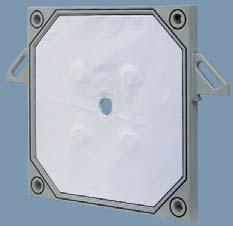Filters are used to separate a liquid-solid or gas-solid mixture. They are used in a wide range of applications, and in many fields, as described below.
Types Of Filter Media
Strainers And Filter Cloth
General Information
Filter cloth or paper consists of different types of fibers layered to create pores that allow liquid to flow through while collecting solid particles. These fibers may be synthetic, such as nylon or polyester, or natural, such as cotton or wool.

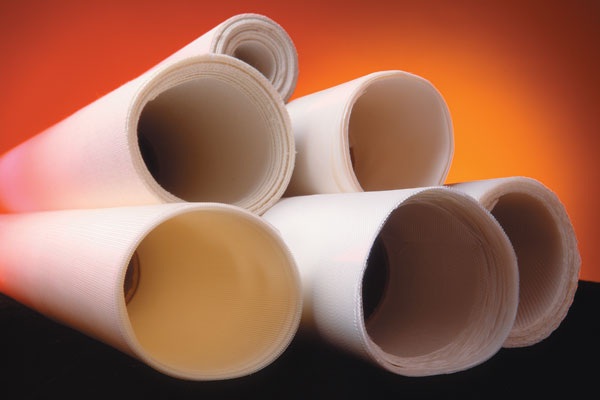
Equipment Design
Most of the time, filter cloth is used for cake filtration. Illustrated in the video below, as the slurry is filtered through the filter medium, solids accumulate on top of the filter medium to form a cake. Eventually, the cake formed performs the actual filtration while the filter medium merely supports the cake.
If soft particles in the fluid block the filter medium, a filter aid can be used. A filter aid is a precoat of fine fibers on the filter medium and in the entering fluid which helps cake formation.
Most filtration procedures that involve a cake can use a wash for maximum filtrate recovery. When a filter cake is washed, a liquid, usually water, is run through the cake to recover any remaining filtrate in the cake. Usually, a maximum of four times the filtrate volume of wash liquid is used.
Usage Examples
A common surface filter used in industry is a strainer or screen. In surface filters, a thin layer of dust (precoat) builds upon the filter at the start of the process. This precoat then acts as the primary filter medium. Strainers are mostly made of wire mesh and are usually used for sludges and slurries containing relatively large solids. Due to their simplicity and low cost, strainers are one of the most commonly used liquid-solid separation devices in the industry. The strainers used to strain food when cooking is the simplest types in use. Strainers are also used often in pool filters.
Sieves, the more general form of a strainer, can be used to separate larger solids from smaller solids. They can be used for the separation of sand, gravel, and rocks.
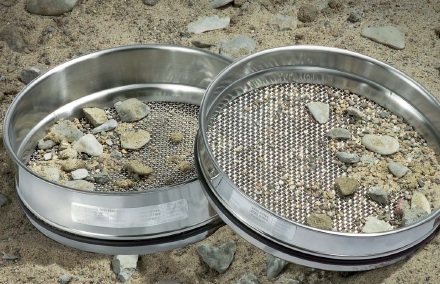
Cartridge Filters
General Information
Filter cartridges consist of rolls of filter media, wound so that several layers of filter media cover each other. These wound cartridges, shown below on the left, are usually contained in a housing that may hold more than one cartridge at a time. The cartridge housing pictured below on the right is a single cartridge system.
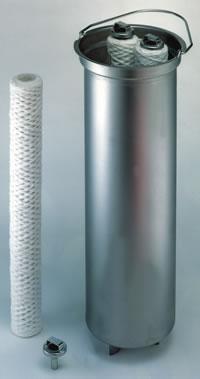

(Pictures copyright Rosedale Products, Inc., Ann Arbor, MI)
Equipment Design
Cartridge filters may be used as surface filters or depth filters. When the cartridge is pleated, it functions as a surface filter, in which the filter media blocks the solid particles from flowing through. When the cartridge consists of wound layers of filter media, it operates as a depth filter, in which the many layers collect the solid particles as the slurry flows through it.
Hybrid systems combine the best features of bag and cartridge systems. These systems have more surface area than standard bag filters and are easier to change than cartridge filters because the collected material stays inside the medium. The picture to the left is an example of pleated cartridges and to the right is an example of wound cartridges.
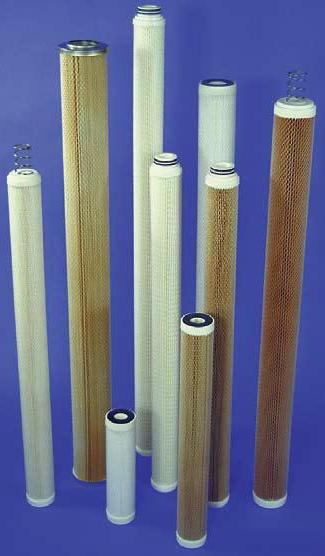
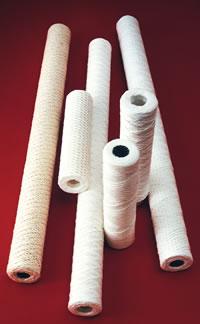
(Pictures copyright Rosedale Products, Inc., Ann Arbor, MI)
Bag Filters
General Information/Equipment Design
Bag filters consist of felt, a porous membrane, or layers of mesh made of natural or synthetic fibers, as shown below on the left. Bag filters can also be made out of polypropylene needle felt. These polypropylene-based bag filters are commonly used in the food, beverage, and pharmaceutical industries because they comply with food contact requirements.
Bag filters are simple in design and inexpensive. They are often placed inside a housing, such as the one below on the right, and a slurry runs through them.
(Pictures copyright Rosedale Products, Inc., Ann Arbor, MI)
Hybrid systems combine the best features of bag and cartridge systems. These systems have more surface area than standard bag filters and are easier to change than cartridge filters because the collected material stays inside the medium.
Usage Examples
Large filter bags are used to collect dust and other contaminants in metal factories, such as the one shown here. Filters such as these are used in the manufacture of iron and steel as well as cement, lime, and clay. They are generally used for removing solid particulates but can be used effectively for filtering fluid materials.
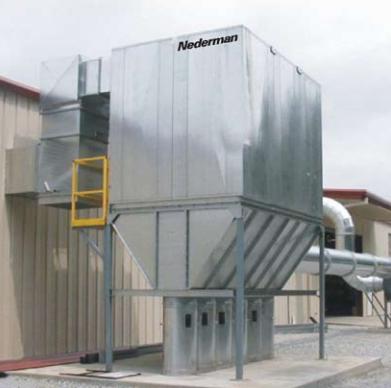
Filtration Techniques
Filter Presses
Filter presses, also known as plate and frame filters, are some of the oldest and most common filters used for liquid-solid separation.
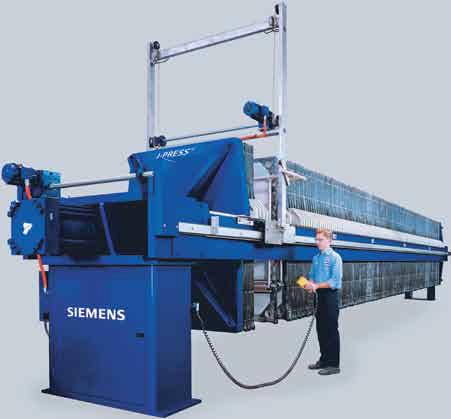
General Information
Filter presses consist of several filter plates in series. These plates are metal frames containing large sheets of filter cloth, usually polypropylene. These plates are squeezed together and the slurry is filtered through the press.
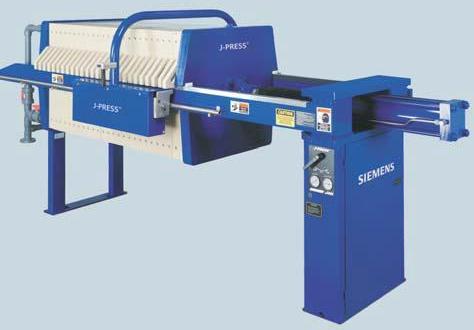

(Copyright Water Technologies Business Unit of Siemens Industry, Inc., Warrendale, PA)
Equipment Design
Filter presses are operated by compressing the plates together to make a water-tight seal, then pumping the feed through a tube down the center of the plates. The slurry deposits solids on the filter cloth as the filtrate leaves the press via discharge ports. The solids continue to deposit and eventually form a cake in the spaces between the filter plates.
(Copyright Water Technologies Business Unit of Siemens Industry, Inc., Warrendale, PA)
For maximum filtrate recovery, air can be blown at high pressures through the filter press to dry out the cake almost completely.
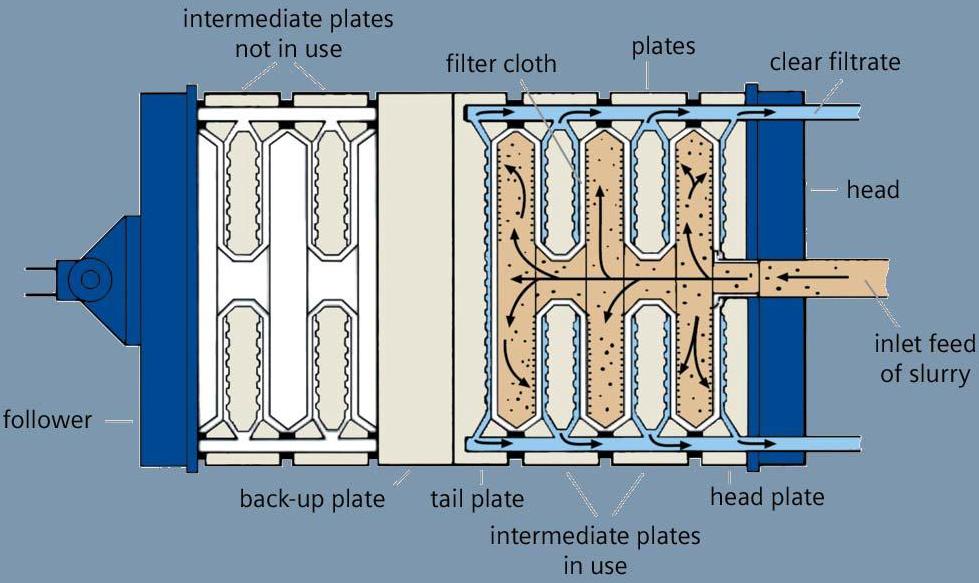
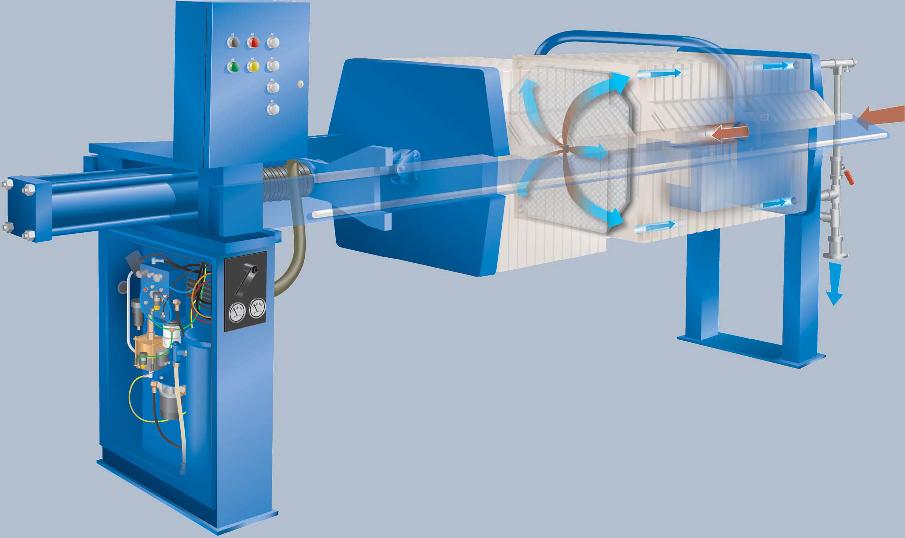
Filter presses can be operated as batch or continuous processes. When operated as a batch process, filtering is paused to remove the filter cake when it has reached a maximum thickness. For continuous processes, the filter press can be modified to deposit the filter cake in drums or barrels, as shown below.
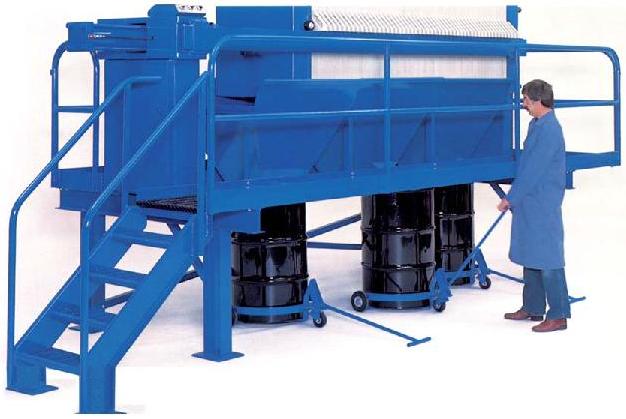
Usage Examples
The portable dewatering system shown here consists of a large filter press mounted on a trailer. This filter press has a standard capacity of 117 cubic feet and can operate at up to 225 psi. Filter presses are also used in the chemical, pharmaceutical, and oil industries.
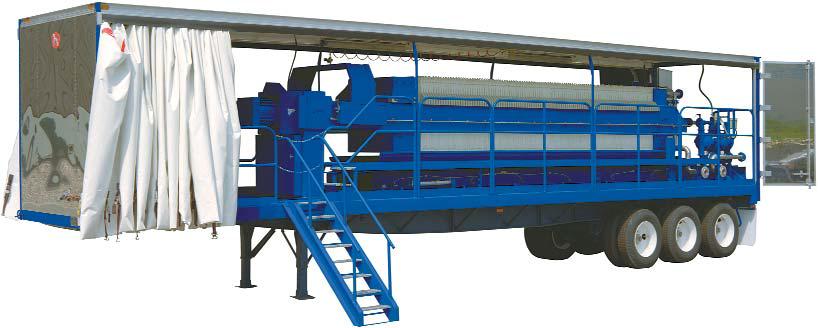
Advantages
- Low operating cost.
- Simple design.
- Can operate efficiently as a batch or continuous process.
Disadvantages
- High maintenance required due to short filter cloth life.
- Frequent leaking or dripping can occur.
- Imperfect washing can occur due to inconsistent cake densities.
Pressure Filters
In pressure filters, a pressure drop pushes the filtrate through the filter medium.
General Information
When the slurry is pumped into a pressure filter, extremely high pressure drives it into the filter medium. The filtrate is forced through, while solids accumulate on the medium. The filter medium is usually belt-driven, or a belt itself, much like a vacuum filter, to achieve continuous operation.
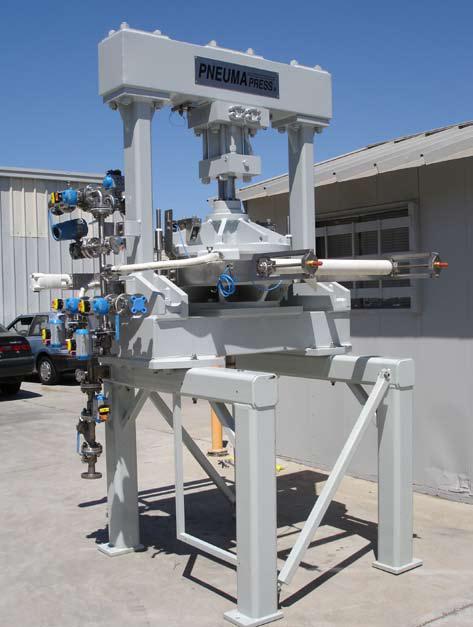
Another type of pressure filter is a pressure vessel filter, in which the filtration device is enclosed in a pressure vessel, and a steady pressure drop forces the filtrate through. Here, discharge of the cake may be difficult, preventing a continuous process.
Equipment Design
Pressure filters are often built as horizontal belt systems. The slurry is pumped into the system, where high pressures in the pressure chamber force the filtrate through the filter medium, which is pulled through the chamber by a belt. The filtrate is then pumped into a reservoir and the cake is deposited in a discharge bin.

In pressure vessel filters, the filtration media is housed inside a pressurized vessel. Slurry is pumped into the vessel, where the filtrate is pushed through the medium. The filtration medium may be in the form of leaves, cartridges, or bags. Most of the housings that contain bag filters or cartridge filters are pressurized.
Most often, pressure vessel filtration is a batch process and filtration must be stopped when cake size is at a maximum for removal.
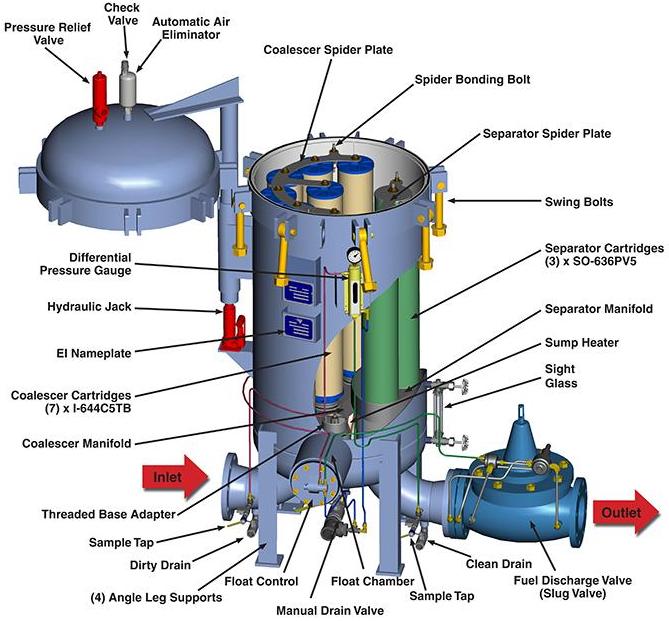
A pressure leaf filter is a pressure-driven filter contained inside a pressurized vessel. Here, the slurry is pushed through several plates of filter media, called filter leaves. The solids collect on the filter leaves and the filtrate is recovered.
This large pressure leaf filter has a retractable shell. The retracted shell and the pressure leaves used for filtration can be seen. The cake is discharged from the leaves into the bottom of the vessel.
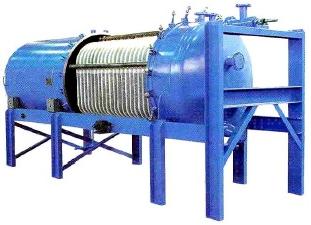
Usage Examples
The pressure vessel filters shown below are used in the aviation industry to remove dirt and separate water from fuel at refineries, product terminals, fuel farms, and refueling vehicles. Other uses include the filtration of seawater and process water on offshore oil platforms.

The multi-module pressure filter shown below is designed to prevent contamination of the filter cake so it can be used for sanitary applications, such as producing food-grade and pharmaceutical products.
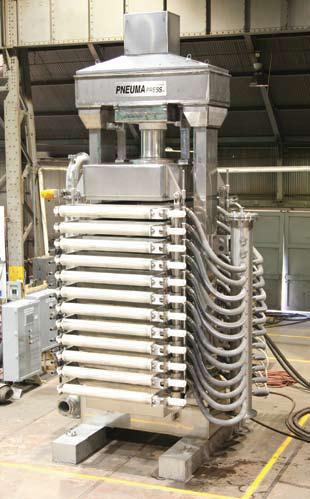
Advantages
- Provides adjustable cake thickness
- Low labor costs
- Capable of very efficient washing
Disadvantages
- If used vertically, cake often forms unevenly
- Cake cannot be efficiently dried for maximum filtrate recovery
Vacuum Filters
Vacuum filters, such as the rotary drum vacuum filter shown here, use the application of suction on the filtrate side of the filter medium during filtration.

General Information
There are two main types of vacuum filters: horizontal belt and rotary drum filters, both of which operate continuously. Horizontal belt vacuum filters include a conveyor belt, while rotary drum filters rotate about an axis as a vacuum pulls the filtrate through its walls. Shown below to the left is an example of a horizontal belt vacuum filter and below to the right is an example of a rotary drum vacuum filter.
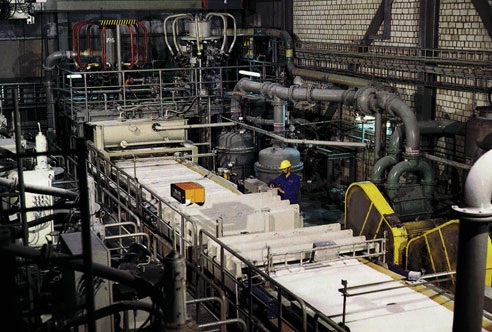
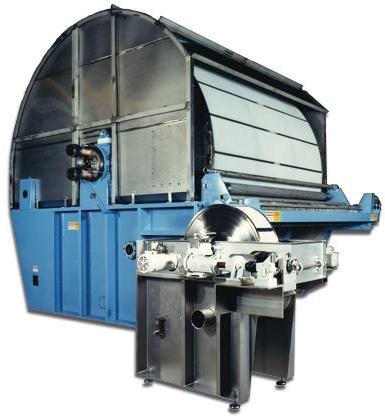
(Pictures copyright Komline-Sanderson, Peapack, NJ)
Equipment Design
Horizontal belt vacuum filters contain a conveyor belt to move filter media from a roll through the machine. As the conveyor belt circulates, it pulls the filter media through the filtration chamber, where a vacuum pulls the filtrate through the media and a cake deposits on the other side. The belt then pulls that section of used filter media out of the machine and deposits it in a discharge bin. The user need only replace the roll of filter media to continue the process.
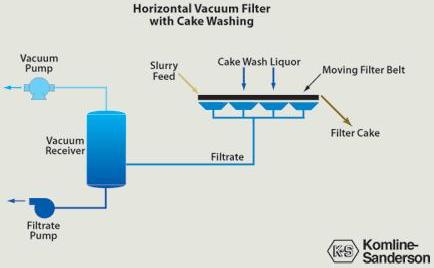
Rotary drum vacuum filters consist of a rotating drum lined with a filter medium that has approximately one-third of its outer wall submerged in the slurry. The filtrate is pulled through the wall of the drum by a vacuum, towards the center of the drum. The drum rotates such that the cake is dumped into the discharge outlet. That section of the drum wall is then washed before performing filtration again.
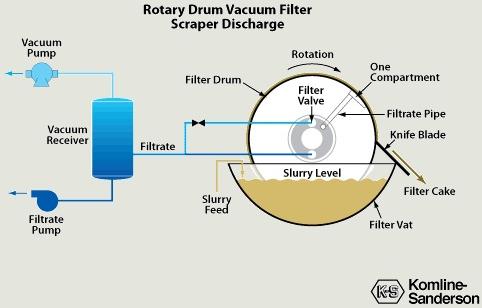
(Animation based on schematic copyright Komline-Sanderson, Peapack, NJ)
Usage Examples
The horizontal vacuum filter pictured below is used for the dewatering, washing, and drying of gypsum that is used in wallboard production.

This vacuum filter is used for the production of a food ingredient. Other uses of vacuum filters include wastewater treatment and the filtration of chemical and industrial wash solutions.
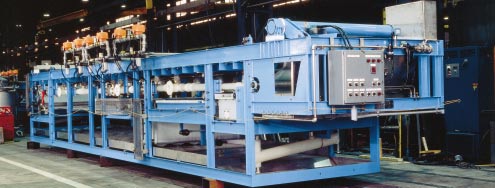
Advantages
- Flexibility in choice of cake thickness, washing time, and drying time
- Can effectively handle heavy, dense solids
- Allows thorough flooding of cake with wash
Disadvantages
- Expensive to build
- Requires a large amount of floor space
- Difficult to enclose for hazardous applications
Fabric Filters
Fabric filters, also known as baghouses, are primarily used in dust collection.
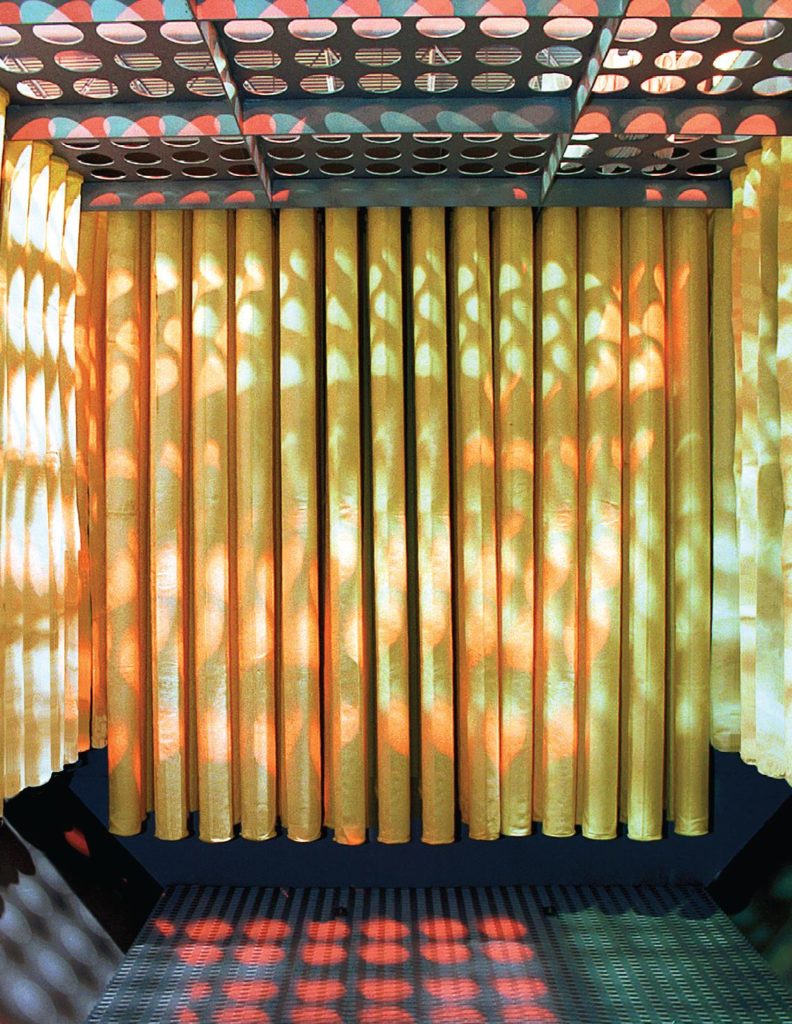
General Information
A fabric filter, shown in operation in the animation, is a type of surface filter.
Dust is removed from a gas stream by passing it through the fabric. The fabric pores are large, so efficiency is low until the dust precoat builds up. Once the precoat is established, penetration is very low. Various methods are used to remove the collected dust and the precoat from the filter. These methods are often expensive and can prove hazardous.
Equipment Design
Baghouse selection and performance depend almost entirely on five variables: gas temperature, fabric material, pressure drop, filtration velocity, and method of cleaning.
Temperature provides the most severe limitation on performance. Natural fibers, such as cotton or wool, can only withstand temperatures up to 90°C (200°F). Glass and synthetic fibers can function at temperatures as high as 230-260°C (450-500°F). The picture below shows a number of natural and synthetic fiber bags.
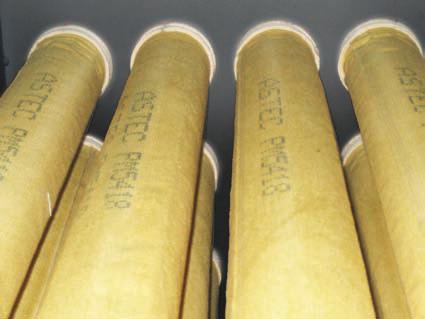
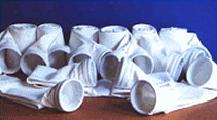
The pressure drop is the difference in pressure between the inside and outside of the bag. The more dust accumulates on the bag, the larger the pressure drop. When a maximum pressure drop is reached, the bag must be cleaned.
The filtration velocity is the ratio of the volumetric flow rate of gas through the compartment to the total surface area of the bags in the compartment. The higher the filtration velocity, the more quickly dust accumulates, and the more often cleaning is needed.
The various methods of cleaning are described below.
The three fabric filter designs are defined by the method of cleaning the bags. The most commonly used fabric filter is the shaker-cleaned type, shown here.
The top of the bag hangs from a shaking mechanism. The bottom, open end of the bag is connected to a hole in a sheet that separates the clean- and dirty-gas chambers. Dirty gas flows up into the bag and dust collects inside the bag. When the pressure drop reaches a specified limit due to dust accumulation, the gas flow stops, the bags are shaken, and the dust falls into a hopper.
The bags in shaker-cleaned filters must be made of woven natural or synthetic fibers to withstand shaking.
Reverse-flow filters are very similar to shaker-cleaned filters. Instead of shakers, though, a fan blows gas from the clean-gas side of the compartment into the bag, partially collapsing it and removing the dust. The bags are fitted with rings to prevent complete collapse, which traps dust. This type of baghouse is often used at temperatures above 150°C (300°F) and contains fiberglass bags that can withstand heat.
In reverse-pulse filters (also known as reverse-jet filters), the filter bag, which is made of felt, fits over a cylindrical wire cage. Dust collects on the outside of the bag and clean gas flows inside the cage. A nozzle, located in the clean gas outlet, releases a short burst of clean gas periodically, expanding the bag and dislodging the dust without disrupting the dirty gas flow.
Usage Examples
The fabric filters shown below are used in an industrial dry filtration process. Filters such as these are also commonly used in metal and mineral processing. The baghouse below collects metal shavings from a saw.
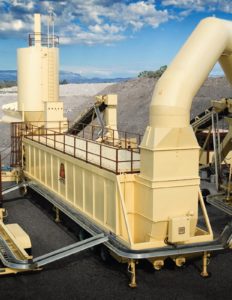
Fabric filters are also used in conjunction with other dust collection equipment in industries such as the pharmaceutical and microelectronics industries, in which very clean air is a necessity. Optimal performance of dust filters has been found by using high-loft, air-laid microfiber glass media. Low resistance to airflow will increase efficiencies.
Advantages
- Generally highly efficient
- Reverse-jet type can be cleaned without disrupting the gas flow
- A variety of combinations of bags and housings provides a wide range of coverage for process needs
Disadvantages
- Reduced efficiency while precoat builds up.
- Shaker-cleaned and reverse-pulse types must be taken off-line for cleaning unless housed in multiple compartments.
- Dislodged dust from reverse-jet type often relocates to other bags in the housing instead of being removed.
- Gas must be completely dry.
- Dust can be explosive, flammable, or toxic
- Expensive to operate and maintain dust filtration systems
Depth Bed Filters
General Information
A common, efficient means of filtering out relatively small particles from a solid-liquid mixture is deep bed filtration. Here, the slurry is filtered through a thick bed of filter medium usually consisting of many grain-sized particles. Some examples of media used in deep bed filtration are sand and silica gel.
Here, as the slurry passes through the bed, the solid particles being filtered out are caught by the grains due to gravity settling, diffusion, or molecular or electrostatic forces, and are separated from the filtrate.
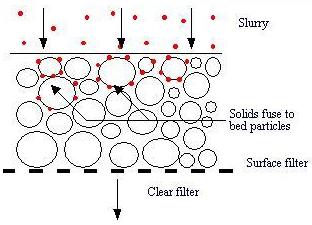
Usage Examples
Depth bed filters, such as the ones shown here, are often contained in pressurized vessels. Filters such as these are usually used in water treatment or to remove contaminants such as solid or oily residues from industrial fluids. The depth bed filter pictured below is used for oil removal prior to a lime softening process, and then used for solid removal and polishing prior to ion exchange. The softener effluent contains less than 1 ppm total suspended solids (TSS).

Magnetic Filters
General Information/Equipment Design
Magnetic filters use a magnetic field to separate particles. The magnetic field permanently magnetizes solid particles in the slurry. These strongly magnetized ferromagnetic particles align along with the magnets and accumulate to form a filter medium. These filters, used commonly for coolant filtration in machines, have low operating costs.
Ceramic Filters
General Information/Equipment Design
There are two types of ceramic filters. High-density ceramic filters are made of alumina or silicon carbide, while low-density ceramic filters are vacuum formed from refractory fibers. The advantages of ceramic filters are that they can be used on process streams up to 900 C and at high pressure. Additionally, they are resistant to corrosion and have a high collection efficiency relative to bag filters.
Because of these properties, ceramic filters are most often used to clean up high-temperature off-gas streams to meet air quality regulations. They can also be used as an alternative to bag filters to meet particulate emissions targets.
Nutsche Filters
A nutsche filter can perform not only filtration but also reactions, washing, and drying in a single unit.
General Information
These filters have tight process control because they are often used for hazardous materials or in industries that require a very sterile environment.
Equipment Design
A nutsche filter operates by using pressure to drive the filter cake through the filter medium. These filters, consisting of a cylinder with a domed top, are sized to accommodate an entire charge of filter cake from the reactor, which requires a large volume vessel up to 25 m 3 . Depending on desired filter properties a woven metallic mesh screen, synthetic filter cloth, or a metallic plate can be used as the filter medium. The filter’s floor, which holds the filtering medium, is reinforced by ribs between the floor and the filter plate so that it can support the weight and pressure from the cake. As the filtrate is drawn through the medium an auger or paddle reslurries or smooths the cake to provide more efficient filtering. The paddle has two arms with blades that rotate to reslurry the material or smooth it by rotating in the opposite direction. The auger also has two arms, but they serve to convey the cake toward the center as it smooths. The paddle and auger are also used to discharge the cake after the cycle is complete.
Usage Examples
Nutsche filters are used in the fine chemical, dye, pharmaceutical, and pesticide industries.
Advantages
- Little risk of environmental contamination
- Can combine multiple unit operations into a single vessel
- Smoothing the cake prevents cracking
Disadvantages
- Long process
- Cake can stick to the filter medium
Acknowledgements
- American Fabric Filter Co., Wesley Chapel, FL
- Astec, Inc., Chattanooga, TN
- Ascension Industries, North Tonawanda, NY
- Filtra-Systems, Farmington Hills, MI
- FLSmidth Inc., Denmark
- Komline-Sanderson , Peapack, NJ
- Nederman LLC , Thomasville, NC
- Rosedale Products, Inc., Ann Arbor, MI
- Velcon Filters LLC, Colorado Springs, CO; now part of Parker
- Water Technologies Business Unit of Siemens Industry, Inc., Warrendale, PA
- W.S. Tyler, Mentor, OH
References
- Cheremisinoff, Nicholas P. and Paul N. Cheremisinoff. Filtration Equipment for Wastewater Treatment. Englewood Cliffs: Prentice-Hall, Inc., 1993: 17-32advan 196-201, 208-209. Print.
- Dickenson, Christopher. Filters and Filtration Handbook. 3rd ed. Oxford: Elsevier Science Publishers Ltd, 1992: 66-73, 129-136, 149-158, 169-179, 189-195, 202-246, 478-496. Print.
- Emmet, Robert C. “Continuous Filtration.” Handbook of Separation Techniques for Chemical Engineers. 2nd ed. Ed. Philip A. Schweitzer. New York: McGraw-Hill, 1988: 4-40 – 4-49. Print.
- Hairston, Deborah. “Putting Absolute Demands on Bag Filters.” Chemical Engineering . 6 (2002): 33-43. Print.
- Halberthal, Josh. “Nutsche Filter.” Engineering Aspects in Solid-Liquid Separation. Web. www.solidliquid-separation.com.
- Iinoya, Koichi, and Richard Dennis. “Industrial Gas Filtration.” Filtration: Principles and Practices. Ed. Michael J. Matteson and Clyde Orr. New York: Marcel Dekker, Inc., 1987: 201-211. Print.
- Ives, K. J. “Deep Bed Filtration.” Solid-Liquid Separation. 3rd ed. Ed. Ladislav Svarovsky. London: Butterworth & Co. Ltd, 1990: 358-378. Print.
- LePree, J. (2018, March). Clearing the Air. Chemical Engineering Essentials for the CPI Professional, 17-20.
- Loff, Lawrence G. “Filter Media, Filter Rating.” Solid-Liquid Separation. 3rd ed. Ed. Ladislav Svarovsky. London: Butterworth & Co. Ltd, 1990: 562-563, 565-574. Print.
- Lozowski, Dorothy. “Controlling Emissions with Ceramic Filters.” Chemical Engineering. 1 2009): 35-39. Print.
- Maas, Joseph H. “Gas-Solid Separations.” Handbook of Separation Techniques for Chemical Engineers. 2nd ed. Ed. Philip A. Schweitzer. New York: McGraw-Hill, 1988: 6-17 – 6-20. Print.
- Nickolaus, Nicholas. “Cartridge Filtration.” Handbook of Separation Techniques for Chemical Engineers. 2nd ed. Ed. Philip A. Schweitzer. New York: McGraw-Hill, 1988: 4-90 – 4-94. Print.
- Osborne, D. G. and H. G. Pierson. “Vacuum Filtration.” Solid-Liquid Separation. 3rd ed. Ed. Ladislav Svarovsky. London: Butterworth & Co. Ltd, 1990: 415-446, 466-475. Print.
- Perry, Robert H., and Don W. Green. Perry’s Chemical Engineers’ Handbook, 7th ed. New York: McGraw Hill, 1997: 17-42 – 17-47, 18-82 – 18-83, 18-88 – 18-89, 18-91 – 18-92, 18-94 – 18-100, 18-102 – 18-103. Print.
- Phelan, Matthew. “Focus on Filtration.” Chemical Engineering. 8 (2008): 53- 54. Print. Svarovsky, L. “Pressure Filtration.” Solid-Liquid Separation. 3rd ed. Ed. Ladislav Svarovsky. London: Butterworth & Co. Ltd, 1990: 379-414. Print.
- Svarovsky, Ladislav “Filtration.” Encyclopedia of Chemical Technology. 4th ed. New York: John Wiley & Sons, Inc., 1993. Print.
- Watson, J. H. P. “High Gradient Magnetic Separation.” Solid-Liquid Separation. 3rd ed. Ed. Ladislav Svarovsky. London: Butterworth & Co. Ltd, 1990: 661-662. Print.
- Wrotnowski, Arthur C. “Felt Strainer Bags.” Handbook of Separation Techniques for Chemical Engineers. 2nd ed. Ed. Philip A. Schweitzer. New York: McGraw-Hill, 1988: 4-101 – 4-110. Print.
- Zievers, James F. “Batch Filtration.” Handbook of Separation Techniques for Chemical Engineers. 2nd ed. Ed. Philip A. Schweitzer. New York: McGraw-Hill, 1988: 4-17 – 4-18, 4-20, 4-23 – 4-30. Print.
Developers
- Matthew Skindzier
- Erica Mauter
- Steve Wesorick
- Joseph Palazzolo
- Kelsey Kaplan
- Andrea Roberts
- Keith Minbiole
- Thomas Plegue
- Austin Potter

